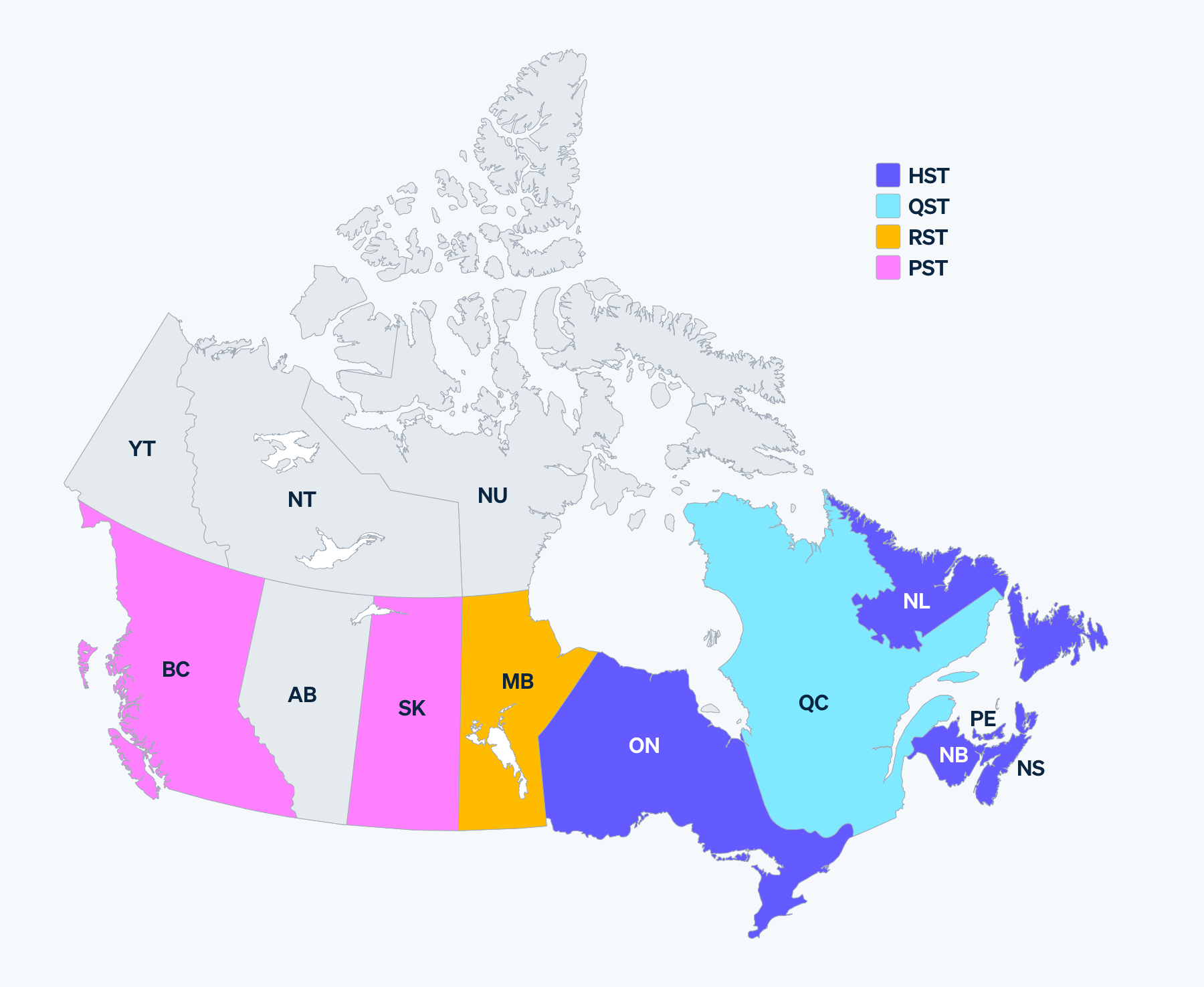在加拿大有纳税义务的企业往往需要遵守多个层面的规定。除了全国性的商品及服务税外,企业还必须考虑各省的具体税收法规。随着企业的发展,确保及时履行税务合规义务也很重要。首先要在有纳税义务的所有地区进行正确的税务注册。
本指南将帮助您确定在加拿大销售时何时需要注册收税,从而避免因不合规而产生的罚款和利息。它还将帮助非居民企业了解在各省进行税务注册的流程。我们还将分享 Stripe 如何帮助您管理持续的税务合规性。
什么是加拿大的商品及服务税 (GST)?
加拿大的税收制度由联邦税和省税组成。商品及服务税 (GST) 适用于全国。新不伦瑞克省、纽芬兰省和拉布拉多省、新斯科舍省、安大略省和爱德华王子岛省这五个省将本省的销售税与商品及服务税进行了协调,实施了统一销售税 (HST),其运作方式与商品及服务税相同。这些省份的企业只需征收 HST。
不列颠哥伦比亚省 (BC)、马尼托巴省、魁北克省和萨斯喀彻温省分别征收省级销售税 (PST)。在魁北克省,PST 被称为魁北克销售税 (QST)。在马尼托巴省,PST 被称为零售税 (RST)。在萨斯喀彻温省和不列颠哥伦比亚省,它被称为 PST。阿尔伯塔省、西北地区、努纳武特地区和育空地区这四个省不征收任何省级销售税。

加拿大各省税收地图。商品及服务税适用于加拿大全国。
什么是 GST 号码?
商品及服务税 (GST) 号码是加拿大税务局 (CRA) 颁发的唯一标识符,用于识别在加拿大注册收取和汇付商品及服务税的企业。注册程序简单明了,可通过 CRA 网站在线注册。
在加拿大注册收税
何时注册
根据一般规则,在加拿大提供商品和服务的非居民企业如果符合以下条件,必须注册联邦商品及服务税 (GST):
- 他们在加拿大开展业务活动的过程中在加拿大提供应税(包括零税率)供应品,并且他们不是小型供应商。
- 他们在加拿大为娱乐场所、研讨会、活动或在加拿大举办的事件提供入场券(即使是小供应商),也应纳税。
- 他们在加拿大举办会议,超过 25% 的代表是加拿大居民(即使他们是小型供应商)。
如果企业在任何一个日历季度和最近连续四个日历季度的全球应税供应量为 30,000 美元或以下,则该企业有资格成为小型供应商。
自 2021 年 7 月 1 日起,对数字经济企业有特殊规定。销售应税数字产品或服务的非居民企业以及未在正常 GST/HST 制度下注册的其他加拿大实体,如果在任一 12 个月期间的收入超过 30,000 加元,则必须进行注册。此类企业可使用简化的 GST/HST 注册程序。必须按照简化 GST/HST 注册的企业,如果满足某些条件,可以自愿申请注册正常 GST/HST。
企业可能希望注册简化的 GST/HST,因为这样更容易申报和缴纳所征收的 GST/HST。以下是简化注册程序的一些好处:
- 您无需向税务管理部门提供通常要求非居民注册 GST/HST 时缴纳的保证金。
- 付款(汇缴)根据您的日历季度报告期按季度进行。对于未使用简化注册程序的企业,申报频率因营业额而异。
- 您可以申请授权以符合条件的外币支付这些款项。
- 由于不允许申请进项税抵扣 (ITC),您需要计算和申报的净税额将得到简化。
如何在加拿大注册收税
在征收 GST 和其他加拿大税之前,您需要向相关税务机关注册。您可以根据简化的 GST/HST 在线进行注册。切记,企业可能未达到国家一级的税务注册阈值,但仍需注册以征收省级税款。
如果您在加拿大的纳税额已超过起征点,并担心自己欠下罚款和需要补税,我们建议您联系税务专家寻求指导。注册后,即可开始收税。在正确注册之前,请勿开始收税。
在不列颠哥伦比亚省注册收税
何时注册
不列颠哥伦比亚省规定,在该省销售应税商品或服务(包括软件和电信服务)的企业,如果在过去 12 个月中向不列颠哥伦比亚省客户销售的所有应税和免税商品或服务的总收入超过 10,000 加元,或预计在未来 12 个月中将超过这一金额,则必须登记缴纳 PST。
鉴于联邦商品及服务税的门槛和各省的门槛,卖家必须保存准确、清晰的收入记录,以确保收取正确的税款。例如,如果不列颠哥伦比亚省的卖家销售额超过 10,000 加元但低于 30,000 加元(商品及服务税起征点),则无需注册征收商品及服务税,只需注册征收 PST。但是,如果卖家预计未来 12 个月的收入将超过联邦税起征点,则必须注册 GST/HST。
如何在不列颠哥伦比亚省注册收税
在收取 PST 之前,您需要向有关税务机关注册。您可以在线注册收取 PST。
如果您在加拿大的纳税额已超过起征点,并担心自己欠下罚款和需要补税,我们建议您联系税务专家寻求指导。注册后,即可开始收税。在正确注册之前,请勿开始收税。
在马尼托巴省注册收税
何时注册
向马尼托巴省交付有形个人财产或在该省招揽和接受销售的马尼托巴省以外的加拿大企业和外国企业必须注册以征收 RST。自 2021 年 12 月 1 日起,马尼托巴省扩大了征税范围,将省外卖家的数字服务销售也纳入征税范围。任何经营在线住宿平台或在线销售平台或提供流媒体服务的人都必须注册以征收 RST。由于省外卖家没有经济关联门槛,因此他们必须从首次销售开始注册。
如何在马尼托巴省注册收税
在征收 RST 之前,您需要在相应的税务机关注册。您可以在线注册征收 RST。
如果您在加拿大的纳税额已超过起征点,并担心自己欠下罚款和需要补税,我们建议您联系税务专家寻求指导。注册后,即可开始收税。在正确注册之前,请勿开始收税。
在萨斯喀彻温省注册收税
何时注册
萨斯喀彻温省以外的加拿大企业和在萨斯喀彻温省进行零售以使用或消费的非加拿大企业必须注册以征收 PST。萨斯喀彻温省对非居民没有经济关联门槛,这意味着需要从第一笔交易开始征收 6% 的 PST。该指南适用于各种数字产品,如数字音频和视频下载、软件、软件服务和基于云的服务。
如何在萨斯喀彻温省注册收税
在征收 PST 之前,您需要在相应的税务机关注册。您可以通过此链接在线注册以征收 PST。
如果您在加拿大的纳税额已超过起征点,并担心自己欠下罚款和需要补税,我们建议您联系税务专家寻求指导。注册后,即可开始收税。在正确注册之前,请勿开始收税。
在魁北克注册收税
何时注册
在魁北克销售的非居民可以在指定系统或一般系统下注册。以下类别的非居民卖家如果在 12 个月内于魁北克的应税销售额超过 30,000 加元,则必须使用指定系统:
- 在魁北克省销售无形动产或服务的加拿大境外卖家
- 向魁北克省消费者出售有形动产、无形动产或服务的魁北克省以外的卖家
如何在魁北克注册收税
在收取 QST 之前,您需要向相关税务机关注册。您可以在线注册征收 QST。
如果您在加拿大的纳税额已超过起征点,并担心自己欠下罚款和需要补税,我们建议您联系税务专家寻求指导。注册后,即可开始收税。在正确注册之前,请勿开始收税。
Stripe Tax 如何提供帮助
Stripe 助力交易市场以更低成本构建并扩展全球支付与金融服务业务,开拓更广阔的增长机遇。Stripe Tax 显著简化全球税务合规复杂度,让您专注业务发展。该系统全自动计算并征收全美各州及 100 个国家/地区的实体与数字商品服务相关的销售税、增值税及商品及服务税。该功能原生内置于 Stripe 平台,无需第三方集成或插件即可快速启用。
Stripe Tax 可帮助您:
- 了解在哪里注册和收税:基于 Stripe 交易数据,研判需代征税费的地区。您可以在几秒钟内在新的州或国家/地区开启税费代收功能。您可以通过在现有的 Stripe 集成中添加一行代码来开始收税;也可以向 Stripe 的无代码产品(例如 Invoicing)添加税费代收功能。
- 注册缴纳税款:如果您的企业位于美国,可以让 Stripe 代为管理税务注册事宜,享受预填申请详情的简化流程——为您节省时间,简化当地法规合规流程。如果您位于美国境外,Stripe 将与 Taxually 合作,帮助您在当地税务机关完成登记。
- 自动收取销售税:Stripe Tax 能自动完成应纳税额的计算与收取,支持数百种产品与服务,并实时同步全球税规与税率更新。
- 简化申报和上缴流程:通过与我们可信赖的全球合作伙伴的合作,用户可以体验到与您的 Stripe 交易数据无缝链接,我们的合作伙伴会帮助您管理申报事宜,让您能够专注于发展业务。
了解有关 Stripe Tax 的更多信息。